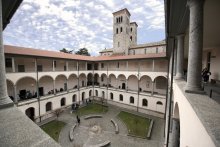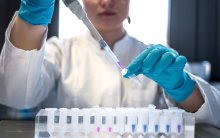Ph.D Course
Restricted access
3 years
Como
Italian
DIPARTIMENTO DI SCIENZA E ALTA TECNOLOGIA
Course description
This PhD program represents an educational and research proposal of “innovative courses” based on an interdisciplinary approach to the issues related to life sciences. The PhD course aims to face with basic research issues with a biotechnological approach, by using different model systems in the biology, biomedicine and (bio)chemistry fields.
The activities have been planned to train a professional figure able to participate to both academic and industrial research activities, highly qualified and skilled to perform scientific investigations, to analyze and evaluate experimental results, to propose and verify scientific hypotheses, to organize and plan a research project, and to communicate the obtained results incisively.
The course aims to prepare PhDs in fundamental fields of life sciences where they can interact and integrate skills arising from basic knowledge in biological, cellular and molecular processes and from industrial and applied biomedical aspects. The vastness of the topics addressed (a peculiar feature of the biotechnology field) requires the definition of training courses partially common to all PhD students, which differentiate during the development of the proposed research projects under the supervision of the PhD mentor. The proposed path is therefore aimed to foster the specificity of scientific profiles through a multidisciplinary and varied offer of training activities, without providing for the rigid organization in curricula.
One main goal of the PhD Course is to reach a high level of internationalization through the involvement in the teaching and research activities of foreign teachers: we strongly encourage PhD students to spend a research period abroad (at least 3 months) and to actively participate to joined international projects.
What you need to know
An application can be submitted by Italian and foreign citizens who have completed or are completing their graduate studies.
Graduate qualifications accepted: all. Graduate qualifications (Master's degree) most related to the aims of the PhD course: Biotechnology; Medicine and surgery; Dentistry; Veterinary medicine; Communication sciences; Bio-sciences; Pharmacy; Psychology; Chemistry and Pharmaceutical technologies; Physics; Environmental Sciences; Engineering; Agricultural Sciences; Food Sciences; Zoo-techniques.
The candidates can choose to be interviewed either in English or Italian.
Enrollment
You can enroll after a public competition based on qualifications and an oral examination. Please see:
Class attendance
The teaching activities (both mandatory and optional) associated with each single year of the Course are proposed annually by the PhD School Board.
Elementi di sicurezza per la gestione dei processi chimici
Teacher: Carlo Lucarelli
Objectives
The course aims to provide the student with the essential elements for risk analysis and the management of chemical processes. The topics covered will provide the student with the key skills to analyse the possible risk sources of a chemical process and evaluate the probability of its occurrence. Furthermore, the concept of risk mitigation and risk prevention for process design and management will be introduced.
Programme
- Description of chemical processes and process units. Introduction to process controls.
- The chemical risk: general aspects. Rules for the correct management of a process
- The concept of risk analysis: Hazard study (HAZOP) and estimation of probability of occurrence (Fault tree)
- Calculation of frequencies of occurrence.
- Consequence Assessment.
- Risk Types, Risk Integration and Risk Attribution.
- Case studies: examples of relevant accidents in the chemical industry.
Learning material
Material provided by the teacher
CV SCIENZE CHIMICHE
Erogato in Lingua Inglese nel caso siano presenti di studenti stranieri
CARBON DIOXIDE AS A SOURCE OF C1 FOR CONVERSION INTO HIGHLY VALUE-ADDED PRODUCTS
Teacher: Stefano Brenna
Objectives: The course will provide an overview of the main synthetic procedures for reusing carbon dioxide as a source of C1 units. At the end of the course, the student will have a broad and comprehensive view on the chemical reactions and technological processes that lead to the conversion of CO2 into products of industrial and applicative interest.
Program: The first part of the course will aim at outlining the issues related to excessive CO2 emissions; then the possible conversions of carbon dioxide into derivatives of academic and industrial interest (carbonates, urea, carbamates, methanol) will be examined. In the last part, different catalytic methods (homogeneous catalysis, heterogeneous catalysis, photocatalysis, electrocatalysis) and materials (MOFs, zeolites, nanoparticles) used for CO2 reuse will be presented.
Learning material: material provided by the lecturer.
CV SCIENZE CHIMICHE
Erogato in Lingua Inglese nel caso siano presenti di studenti stranieri
MITIGATION AND ADAPTATION ACTIONS TO CLIMATE CHANGE
Teacher: Francesco MALFASI
Objectives: Provide theoretical and applied knowledge (also through case studies) concerning mitigation and adaptation to climate change, with particular focus on the biological (vegetation) component of the terrestrial ecosystems. All these aspects will be treated under a regulatory, scientific and technical points of view, at different spatial details.
Programme: Definitions and identification of the application areas of the main topics of adaptation and mitigation to climate change. Strategies and regulations at supranational, national and/or local levels. Decision-making procedures to evaluate, select, apply and monitor good practices for the mitigation and adaptation to climate change related to the plant component, in natural, semi-natural and anthropic environments. Analysis of case studies.
The course lasts 12 hours.
CV SCIENZE CHIMICHE E AMBIENTALI
Erogato in Lingua Inglese nel caso siano presenti di studenti stranieri
MOLECULAR ECOLOGY
Teacher: Serena Zaccara
AIMS:
The goal in this course is to learn and understand principles of ecology and environmental sciences through the application of molecular tools. The main Expected learning outcomes are:
i) analysis of the complexity within interspecific and intraspecific relationships applying the General Theory of Systems
ii) analysis of community ecology defining the structural and functional relationships
introducing evolutionary adaptative models
iii) principles and methods of conservation genetics, introducing population connectivity
and its evolutionary implications applied to aquatic and terrestrial species and
ecosystems.
CONTENTS:
the course will be divided into three parts, for which 4 hours will be dedicated each one.
i) Complexity in ecosystem and The General Systems Theory
lectures will be dedicated to molecular approaches that allow to infer interspecific and intraspecific variability, able to summarize the complexity of ecosystems
ii) Ecology and adaptative evolution
Lectures will deal the dynamics and mechanisms that regulate communities and population, especially paying attention on genetic fingerprint promoted by distinct ecological traits.
iii) Conservation genetics
Lectures will emphasize the key role of conservation genetics in the development of conservation and management strategies of biodiversity.
Each lecture will present case studies useful to deep into the topics, introducing the last molecular techniques dedicated to.
TEXT: slides produced by teacher and scientific papers
CV SCIENZE AMBIENTALI
Erogato in Lingua Inglese nel caso siano presenti di studenti stranieri
IMPACTS OF CLIMATE CHANGE ON THE CRYOSPHERE
Teacher: Mauro Guglielmin
Contribution of the course to the overall degree programme goals
The course will expose students to fundamental aspects linking together global climate processes and cryosphere. The course has been organized in such a way that the first module will provide key aspects regarding the analyses of the main cryospheric elements such as snow, glaciers, sea ice and permafrost while the second module will deal with impacts of permafrost degradation and the glaciers shrinkage and melting.
Pre-requirements
There are not major requirements for this course. The course itself is meant to provide basic tools for students to deal with permafrost-related topics
Contents
1.1 Cryosphere definitions and methods of analyses; snow, ice sheets, ice shelves, glaciers, sea ice and permafrost (3 hours);
1.2 Relationships between climate change (CC) and the cryosphere (3 hours)
1.3 Impacts of CC on snow and glaciers s.l.(3 hours)
1.4 Impacts of CC on permafrost (3 hours)
Referral texts
In the class we will be discussing textbook chapters and seminal papers
Teaching methods
The lecturer will be given by the lecturer and will be implemented also with the discussion on some seminal papers with the students
CV SCIENZE AMBIENTALI
Erogato in Lingua Inglese nel caso siano presenti di studenti stranieri
FIRE SIMULATION IN CONFINED ENVIRONMENT
Teacher: Bruno Dal Lago
AIM OF THE COURSE
The aim of the course is to provide the students with the following skills: (a) definition and organisation of Fire Engineering, (b) phenomenology of fires in confined environment, (c) modelling of the fire load, (d) analysis of fire simulation strategies and nominal method, (e) methods alternative to nominal: parametric, zone, computational thermal-fluid-dynamics.
LEARNING OUCOMES
• Cognitive skills
- acquire the fundamentals information needed to address the simulation of a fire
- acquire the structure of Fire Safety Engineering
- being able to autonomously select and apply a model of fire either nominal, parametric or zone
- being able to critically address and set a complex fire simulation based on thermal-fluid-dynamics
• Learning abilities
- ability to read, understand and criticize a scientific text about fire simulation
• Practical and subject specific skills
- ability to propose a problem-solving approach
- ability to use a freeware software for the simulation of fires with zone model
• Communication skills
- ability to identify, extract and synthesize relevant information
- demonstrate effective communication skills by practicing, reading, writing and speaking clearly
- demonstrate the ability to communicate with industry experts.
Slides of lectures delivered by the lecturer.
Specific scientific/technical papers suggested by the lecturer.
CV SCIENZE CHIMICHE E AMBIENTALI
Erogato in Lingua Inglese nel caso siano presenti di studenti stranieri
CONFINEMENT IN POROUS MATERIALS
Teacher: Gloria Tabacchi
Objectives
This Course aims to give an overview of host-guest materials constituted by nanometer-size guest species and nanoporous host matrices, whose potential applications hold concrete promises in materials science. Supramolecular organization is a central idea in chemistry and a driving force in technology. It refers to the formation of correlated domains of molecules or nanospecies exhibiting collective properties or new functionalities. A key objective of this Course is to provide a knowledge-base on the confinement of guest species in host matrices characterized by regular porous networks. Confinement in nanometer-size spaces is particularly effective to the obtainment of supramolecular organization of guest species, because such cavities can be exploited as nanosized receptors for matter to create confined, supramolecular structures of low-dimensionality. Another goal of this Course is to show that, when confined in those matrices, guest species not only are subjected to the geometrical constraints of the cavities, but are also prone to be remotely and individually controlled by an external input (e.g. electromagnetic radiation).
Program
Focus will be driven on the molecular-level features of the confined assemblies, whose knowledge is pivotal for progress in applications. The relevance of natural and artificial porous matrices to probe fundamental aspects of host-guest interactions and confinement in nanosized spaces will be analyzed. The main categories of host matrices suitable for the supramolecular organization of guest species will be presented. Relevant procedures for the fabrication and characterization of host-guest materials will be outlined. Among viable strategies for the realization of host-guest materials of potential technological interest, particular attention will be devoted to the use of high pressures.
Texts
The material (current literature on the subject) will be provided by the lecturer.
CV SCIENZE CHIMICHE
Erogato in Lingua Inglese nel caso siano presenti di studenti stranieri
NON-INVASIVE CHARACTERIZATION OF MATERIALS
Teacher: Laura RAMPAZZI
Objectives: The course provides basic knowledge of the main non-invasive techniques to explore their use in the environmental and forensic fields and in the analysis and diagnostics of works of art.
Programme: Introduction to non-invasive analytical methods. Description of main spectroscopic, X-ray, photographic, multispectral non-invasive techniques. Determination of materials and study of surface decay. Presentation and discussion of case studies.
Teaching materials: Scientific articles and reviews on the subject provided by the teacher.
CV SCIENZE CHIMICHE
Erogato in Lingua Inglese nel caso siano presenti di studenti stranieri
METHODS AND MODELS FOR THE EXPOSURE ASSESSMENT TO CHEMICALS
Teacher: Andrea Spinazzé
Objectives: The course aims to illustrate the main theoretical and practical issues related to the use of estimation models and other experimental methods used for the assessment of occupational and environmental exposure to chemicals, with particular reference to case studies related to emerging risk factors and the latest updates in the exhibition sciences.
Programme:
General aspects relating to the chemical risk assessment.
Estimation of occupational exposure to chemical agents using estimation models: methodological and practical aspects; reliability and representativeness of the exposure estimates.
Approaches and methodologies for assessing the risks of combined exposure to multiple chemicals.
Emerging risk factors: use of a probabilistic approach for risk assessment (the case of occupational exposure to engineered nanomaterials).
Exposure of the general population to airborne pollutants, for epidemiological studies and the health impact assessment: exposure estimation (dispersion models; Land-use regression model), use of miniaturized sensors for monitoring selected populations and approach, ”citizen-science”.
Teaching materials: W.R. Ott, A.C. Steinemann, L.A. Wallace: “Exposure Analysis” – CRC Taylor and Francis (ISBN– 13: 978-1-56670-663-6). Slides (pdf).
CV SCIENZE CHIMICHE E AMBIENTALI
Erogato in Lingua Inglese nel caso siano presenti di studenti stranieri
ACTIVE TECTONICS AND EARTHQUAKE GEOLOGY: SAVING LIVES AND INVESTMENTS FOR A SUSTAINABLE WORLD
Teacher: Franck A. Audemard M.
COURSE OBJECTIVES
• Revise the different possible sources of earthquakes and their association with geologic faults. Discuss the theory of earthquake generation, as well as the relation between size of earthquakes and fault ruptures;
• Transfer knowledge on how the seismic history of a region is obtained by integrating instrumental, historical and pre-historical seismicity;
• Examine and identify earthquake-related landforms and the impact of earthquakes on nature;
• Evaluate how seismic hazard studies are carried out;
• Illustrate how paleoseismological investigations are performed and what objects can be analyzed in such a way.
• Determine the importance of geological studies into a seismic hazard assessment (SHA).
SPECIFIC LEARNING OUTCOMES
1. Determine and improve the degree of knowledge of the course audience in relation to plate tectonics and its major association to Earth surface processes;
2. Understand that destructive earthquakes are related to geologic faults, which accommodate strain in the crust driven by plate tectonics;
3. Learn how to identify Quaternary faults via specific landforms and landscapes and how the environment can be affected by earthquakes;
4. Understand how to build a seismic history in a region from different sources of data gathering and the importance of the geological studies for any seismic hazard assessment (SHA);
5. Learn that a safer constructed environment preserves human life and that earthquakes naturally may severely impact landscape and the environment.Erogato in Lingua Inglese nel caso siano presenti di studenti stranieri
CV SCIENZE AMBIENTALI
For information
Address: c/o Dipartimento di Biotecnologie e Scienze della Vita - DBSV
Università degli Studi dell'Insubria
Via Dunant, 3 - 21100 Varese - Italy
Cordinator: Prof. Alessandro Maria Michetti (alessandro.michetti@uninsubria.it)
PhD Course website: www.dbsm.uninsubria.it/phdbbtc/





